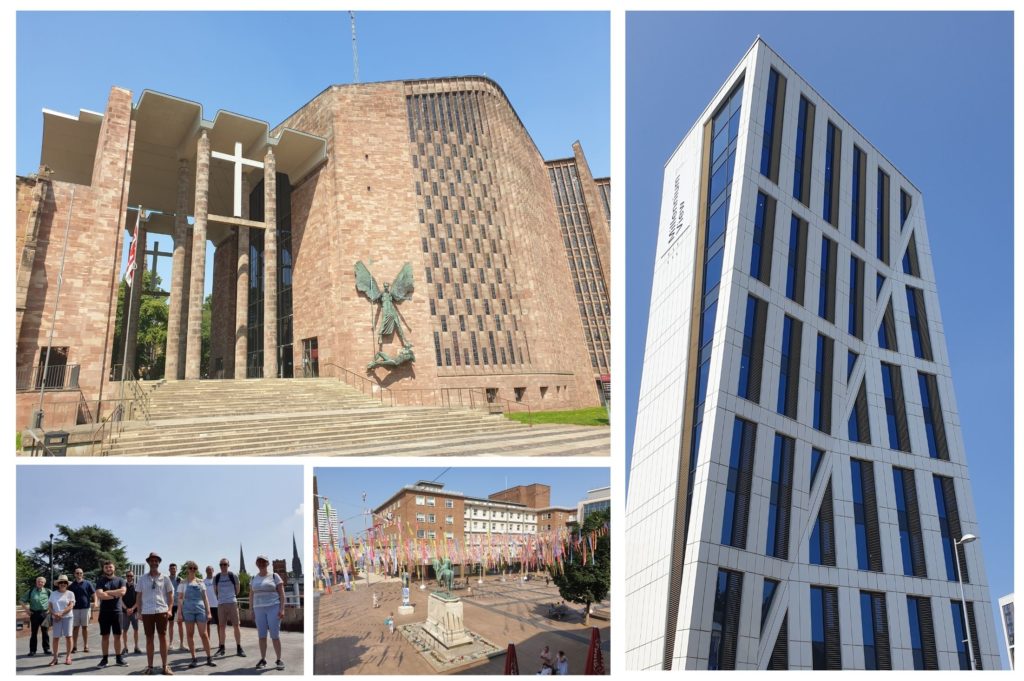For the first time, in what seemed a long, long time, the Planning & Design team were all together and being “sent to Coventry”, as we resumed our annual Study Day tradition with a trip to the UK City of Culture 2021.
Making the most of the “Freedom Day” relaxation of the Covid-19 restrictions that had necessitated home and flexible working for our team of architects and town planners, and unable to organise a trip in 2020, this was the first time our full team had all been together in over 18 months.
Coventry was the fastest growing city in Britain between the First and Second World Wars. With its medieval streets becoming congested and overcrowded, in 1938 the City Council appointed Donald Gibson to become the first city architect. The newly created City Architect’s Department had ambitious plans, and the devastation of the Coventry Blitz, especially the air raid of 14th -15th November 1940 afforded it the opportunity to design and implement an entirely new city centre. This as we were to discover, offered a wealth of architectural styles for us to explore- Brutalist, modernist and medieval all sitting side by side.
The re-planning of Coventry City Centre had started before the Blitz; it was the extensive war time damage, that both directed and enabled Gibson and the City Architect’s Department to turn the ambitious plans into reality. His legacy was apparent throughout the city with buildings such as Broadgate House, the Upper and Lower precincts and the Herbert Art Gallery and Museum, where we began our tour, all bearing testament to his ethos to reimagine a city centre, what it could and should be. Gibson’s then novel town planning concept to separate traffic and pedestrians resulted in Europe’s first car free shopping precinct and the various zones earmarked for retail, religion, administration, and recreation, are still in evidence today.
From the Herbert Art Gallery and Museum, we moved on to explore the modernist Cathedral Church of St Michael. This is one of three cathedrals in Coventry, the first was St Mary’s, a monastic building, of which only a few ruins remain and the second St Michael’s, a 14th-century Gothic church later designated as a cathedral. A ruined shell after its bombing during the Second World War, this now serves as a garden of remembrance and sits alongside the new cathedral of St Michael. Designed by Basil Spence and Arup, built by John Laing and a Grade I listed building, the new cathedral was consecrated on 25 May 1962, with Benjamin Britten’s War Requiem, composed for the occasion, premiered in the new cathedral to mark the occasion.
Gibson’s legacy continues to be felt in Broadgate, which has been at the heart of the city for almost 1,000 years. Civic offices Broadgate House was the first new building to be completed and was opened in May 1953. It was later followed by the Owen Owen department store, now Primark and the Hotel Leofric in 1955, which is now Mercia Lodge, a development of student flats since 2008 and with the old hotel ballroom now home to a climbing wall. The remaining side of the Broadgate square was temporary shops until being replaced by Cathedral Lanes in 1990, a £20 million- plus development that has helped transform the city’s leisure economy. Obviously a great spot to stop for lunchtime refreshments!
Coventry’s most (in)famous resident, Lady Godiva also makes her presence felt in Broadgate with her “Self Sacrifice” sculpture taking pride of place in the square, whilst the Lady Godiva Clock, installed in 1953 recalls, every hour on the hour, the legend of her legendary ride naked through Coventry. Peeping Tom, the tailor who disobeyed her wishes not to peek is seen to look out of an upper window, being struck blind he certainly paid a heavy price for his curiosity!
Sir Donald Gibson CBE left Coventry in 1955, becoming County Architect in Nottinghamshire. He was subsequently knighted and became the government’s senior architect, responsible for raising architectural standards, across the UK.
We left Coventry, having soaked up the atmosphere, and the sunshine (a rarity on a PDP Study Day when we normally plan for rain!) and having been impressed at how the city is continuing to re-invent itself, repurposing its buildings and its sense of identity as it looks to build upon the opportunities afforded by its City of Culture status.



